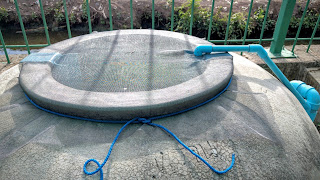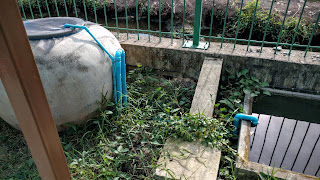The slow sand filter that we use to treat both the untreated greywater and the aerobic treatment system (ATS) treated black water has been working quite well. Now that it has been running in its final configuration for a few weeks, we are planning on sending the output water to be professionally tested pretty soon to see whether the water is safe for irrigation use or not.
The effluent from the ATS doesn’t have anywhere near the smell of a typical septic system. But it does have a hint of that sewage smell and has a cloudy appearance. This can be smelled faintly if you stick your head right into the top of the urn holding the slow sand filter. But the output water is both completely clear and without any smell at all. So from a preliminary superficial observation, the filter is doing pretty well.
But the only problem we have been having is that the water sits in the sand filter and moves through slowly enough that mosquito have no problem laying eggs in it and the larva were visible.
So we just tied a mosquito screen over it…
For the fist few days, you could see the baby mosquitoes inside. Presumably these were from the hatched larva. A few days later, you could see the dead mosquitoes in the water. After about a week, the water in the sand filter has no sign of mosquitoes.
But looking in today, I could some a number of very tiny creatures moving around in the water that clearly were not mosquito larva. I’m wondering if these are daphnia, a kind of plankton that I’ve read eat bacteria and are part of the natural process of breaking down nitrates and otherwise cleaning up water.
Anyway, I’ll give it a few more weeks for the schmutzdecke layer to better form and then get the input and output water tested to see how well my filter is performing. If it really does work well, I will seriously consider using one of these on the floating house to treat the grey water and dump it back out into the pond. (I won’t dump the black water back into the pond no matter what. Too risky.)

